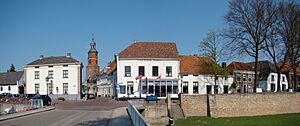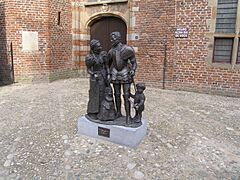Buren facts for kids
Quick facts for kids
Buren
|
|||
|---|---|---|---|

Buren
|
|||
|
|||

Location in Gelderland
|
|||
| Country | Netherlands | ||
| Province | Gelderland | ||
| Government | |||
| • Body | Municipal council | ||
| Area | |||
| • Total | 142.92 km2 (55.18 sq mi) | ||
| • Land | 134.26 km2 (51.84 sq mi) | ||
| • Water | 8.66 km2 (3.34 sq mi) | ||
| Elevation | 5 m (16 ft) | ||
| Population
(May 2014)
|
|||
| • Total | 26,136 | ||
| • Density | 195/km2 (510/sq mi) | ||
| Time zone | UTC+1 (CET) | ||
| • Summer (DST) | UTC+2 (CEST) | ||
| Postcode |
Parts of 4000 and 4100 ranges
|
||
| Area code | 0344, 0345 | ||
Buren (which sounds like BYOO-run) is a town and municipality in the Betuwe region of the Netherlands. As of January 1, 2022, Buren is home to 27,168 people.
Contents
Where is Buren Located?
Buren is found in Gelderland, a province in the central part of the Netherlands. It is part of the Betuwe area. This is a very fertile strip of land located between two branches of the Rhine-Meuse Delta. These rivers are the Nederrijn to the north and the Waal to the south.
Towns and Villages in Buren
The municipality of Buren includes several towns and villages. These are:
- Aalst
- Asch
- Beusichem
- Buren
- Eck en Wiel
- Erichem
- Ingen
- Kerk-Avezaath
- Lienden
- Ommeren
- Ravenswaaij
- Rijswijk
- Zoelen
- Zoelmond
Buren's Rich History
People first settled in the Buren region as early as the year 772. Castle Buren was built by the Lords of Buren. It was first mentioned in records in 1298.
Becoming a City
In 1395, Sir Alard IV of Buren gave the town its city rights. This important step led to the building of a strong defensive wall and a moat around the town. Many parts of these old defenses can still be seen today. In 1492, the area became a county, which meant it was ruled by a count. However, it did not have much economic power because it was quite isolated.
Religious Changes
By 1574, the local church, Saint-Lambert (Dutch: Sint Lambertus), changed from being Catholic to Calvinist Reformed Protestant.
Connection to the Royal Family
The Castle of Buren eventually became owned by the House of Orange. This is the royal family of the Netherlands. The Dutch royal family has even used the name van Buren as a secret name to travel without being recognized. William III of England also held the title of Buren. The Dutch royal family still uses this title today. Sadly, the castle was slowly taken down between 1804 and 1883.
American Connection
The eighth president of the United States, Martin Van Buren, had ancestors from this town. They took the last name Van Buren after moving to the Dutch colony of New Netherlands. This area is now the state of New York. In 1853, after his time as president, Van Buren visited Buren during a trip to Europe. He reportedly met some of his distant relatives there.
Modern Buren Municipality
The current municipality of Buren was formed through two mergers. On January 1, 1978, the towns of Beusichem, Zoelen, and part of Buurmalsen joined the existing municipality of Buren. This original Buren municipality was formed in the mid-1800s. Then, on January 1, 1999, Buren grew even larger. It added the municipalities of Lienden and Maurik.
Places to Visit in Buren
Buren has some interesting historical sites and museums:
- The Museum of the Royal Military Police: This museum is located in a building that used to be an orphanage in the 1600s.
- The Museum of the Dutch Royal Family: You can find this museum in the town's historic city hall.
- De Prins Van Oranje: This is a beautifully restored windmill that you can visit.
Who Lives in Buren?
The people living in Buren come from different backgrounds:
Sister City
Buren has a special connection with another town across the ocean:
Famous People from Buren
Some notable people have come from Buren or nearby areas:
- Philip William, Prince of Orange (1554 in Buren – 1618): He became the Prince of Orange in 1584.
- Gerard de Kruijff (1890 in Buren – 1968): A Dutch horse rider who competed in the 1924 and 1928 Summer Olympics.
- Lukas Smits (born 1935 in Ravenswaaij): A Dutch painter.
- Jos Beijnen (born 1956 in Beusichem): A Dutch pharmacist and university professor.
- Ron Stevens (born 1959 in Lienden): A Dutch sprint canoer who competed in two Summer Olympics.
Images for kids
-
A statue in the center of Buren showing William of Orange and Anna van Buren.
See also
 In Spanish: Buren para niños
In Spanish: Buren para niños














